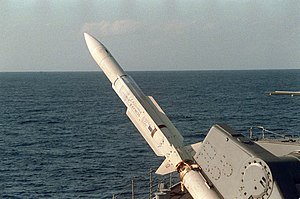| RIM-67 Standard ER | |
|---|---|
 | |
| Type | Extended range surface-to-air missile with anti-ship capability |
| Place of origin | United States |
| Service history | |
| In service | 1981–present (RIM-67B), 1999–present (RIM-156A) |
| Production history | |
| Manufacturer | Raytheon Missiles & Defense |
| Unit cost | $409,000 |
| Specifications | |
| Mass | 2,980 lb (1,350 kg) SM-2ER Block IV: 3,225 lb (1,463 kg) |
| Length | 26.2 ft (8.0 m) SM-2ER Block IV: 21 ft 6 in (6.55 m) with booster |
| Diameter | SM-2ER Block IV: Main body: 13.5 in (34.3 cm) Booster: 21 in (53.3 cm) |
| Wingspan | 5 ft 2 in (1.57 m) SM-2ER Block IV: 3 ft 6 in (1.07 m) |
| Warhead | Radar proximity and contact fuse, high explosive 137 lb (62 kg) continuous rod, later blast fragmentation |
| Engine | Two-stage, solid-fuel rocket; sustainer motor and booster motor |
Operational range | 65–100 nmi (120–185 km) SM-2ER Block IV: 100–200 nmi (190–370 km)[1] |
| Flight ceiling | 80,200 ft (24,400 m) |
| Maximum speed | Mach 3.5 |
Guidance system | Inertial/SARH |
Launch platform | Surface ship |
The RIM-67 Standard ER (SM-1ER/SM-2ER) is an extended range surface-to-air missile (SAM) with a secondary anti-ship capability, originally developed for the United States Navy (USN). The RIM-67 was developed as a replacement for the RIM-8 Talos, a 1950s system deployed on a variety of USN ships, and eventually replaced the RIM-2 Terrier as well, since it was of a similar size and fitted existing Terrier launchers and magazines. The RIM-66 Standard MR was essentially the same missile without the booster stage, designed to replace the RIM-24 Tartar. The RIM-66/67 series thus became the US Navy's universal SAM system, hence the designation "Standard Missile".
- ^ "US Navy: Standard Missile". US Navy. Retrieved 16 December 2022.